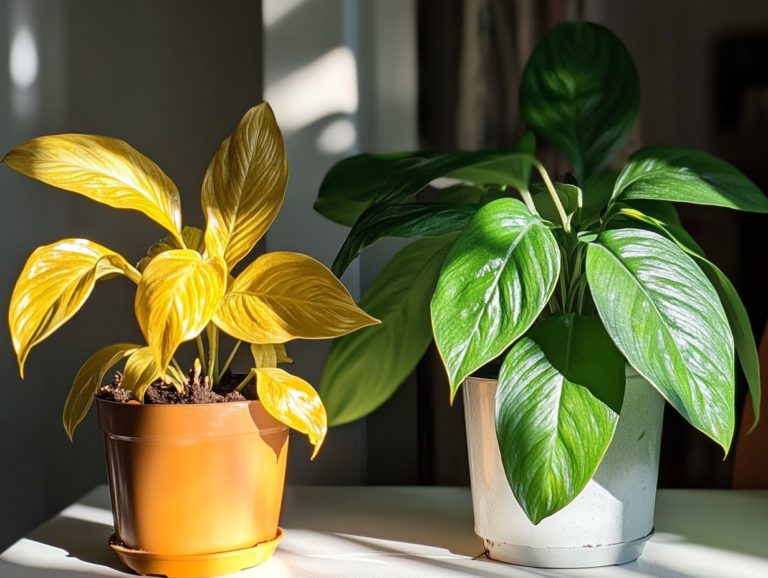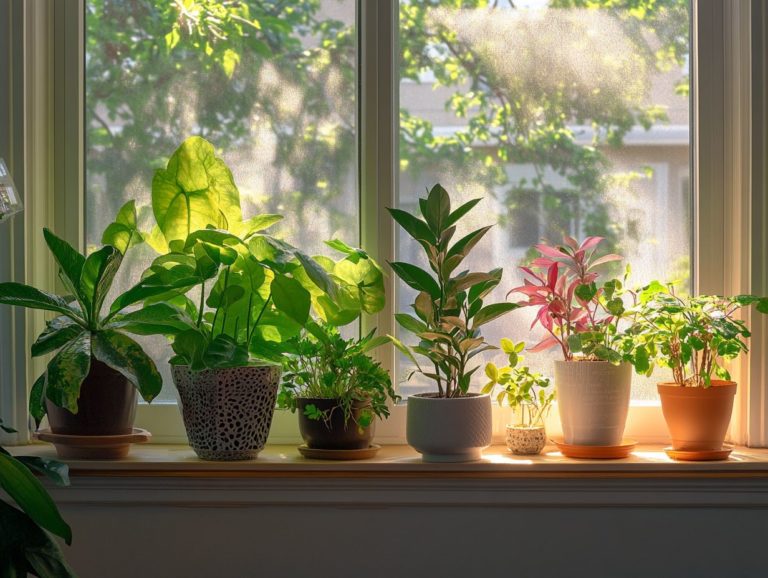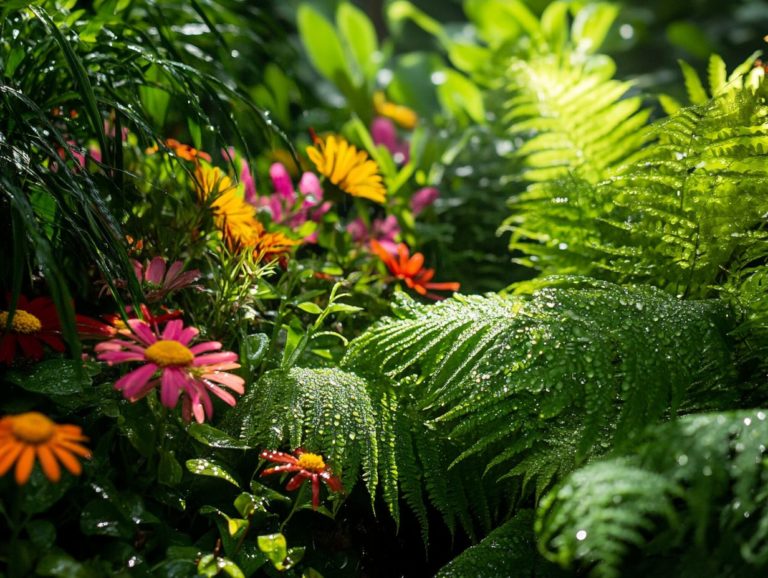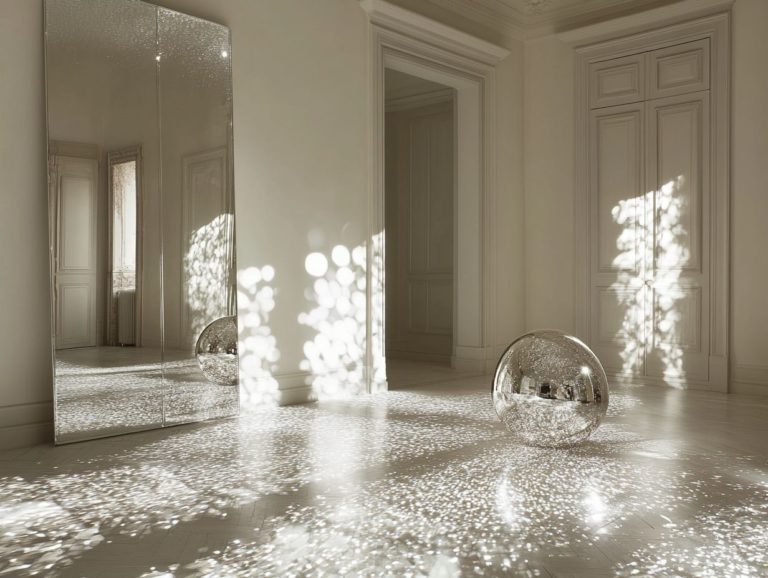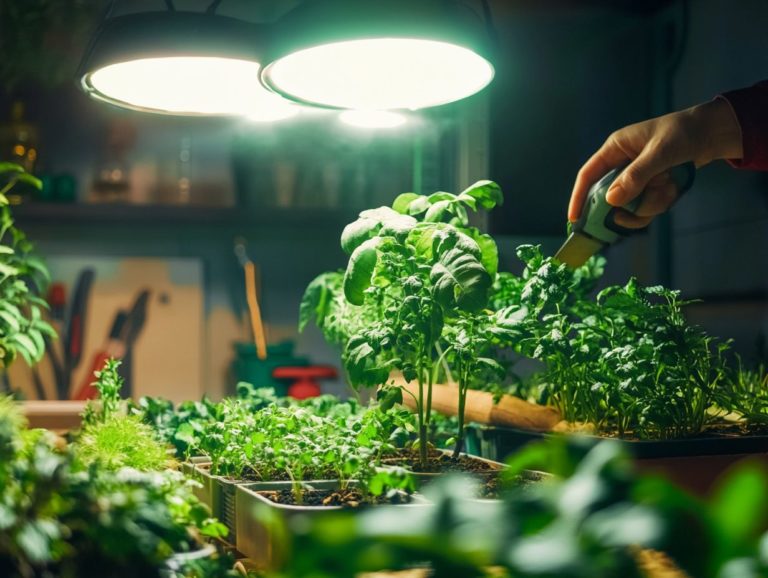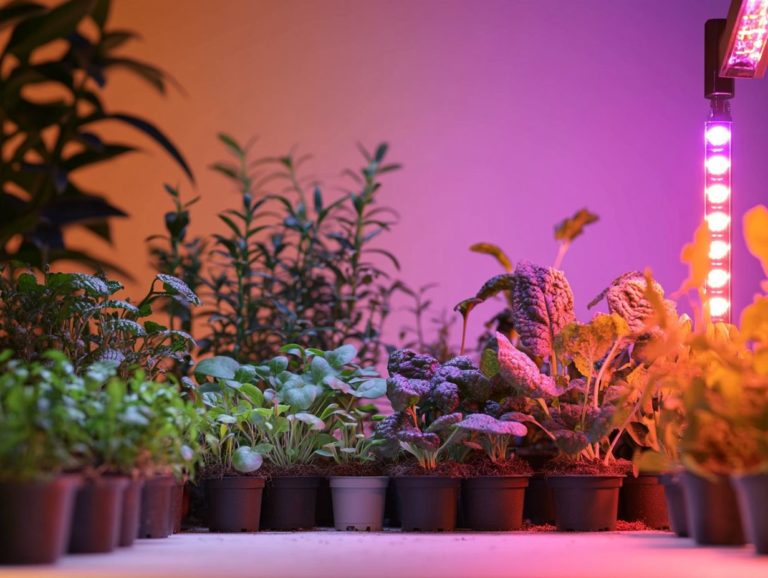Optimal Light Conditions for Succulents
Succulents have a remarkable way of captivating enthusiasts with their unique shapes and bright colors. However, a common misconception is that these resilient plants flourish in any lighting condition.
In truth, knowing the specific light needs of succulents is vital for their health and growth. This article delves into the varying light requirements for different types of succulents, guiding you in creating the ideal environment for your green companions.
From basking in direct sunlight to thriving under artificial lighting, it covers all the essentials you need to ensure your succulents remain vibrant and flourishing.
Contents
Key Takeaways:
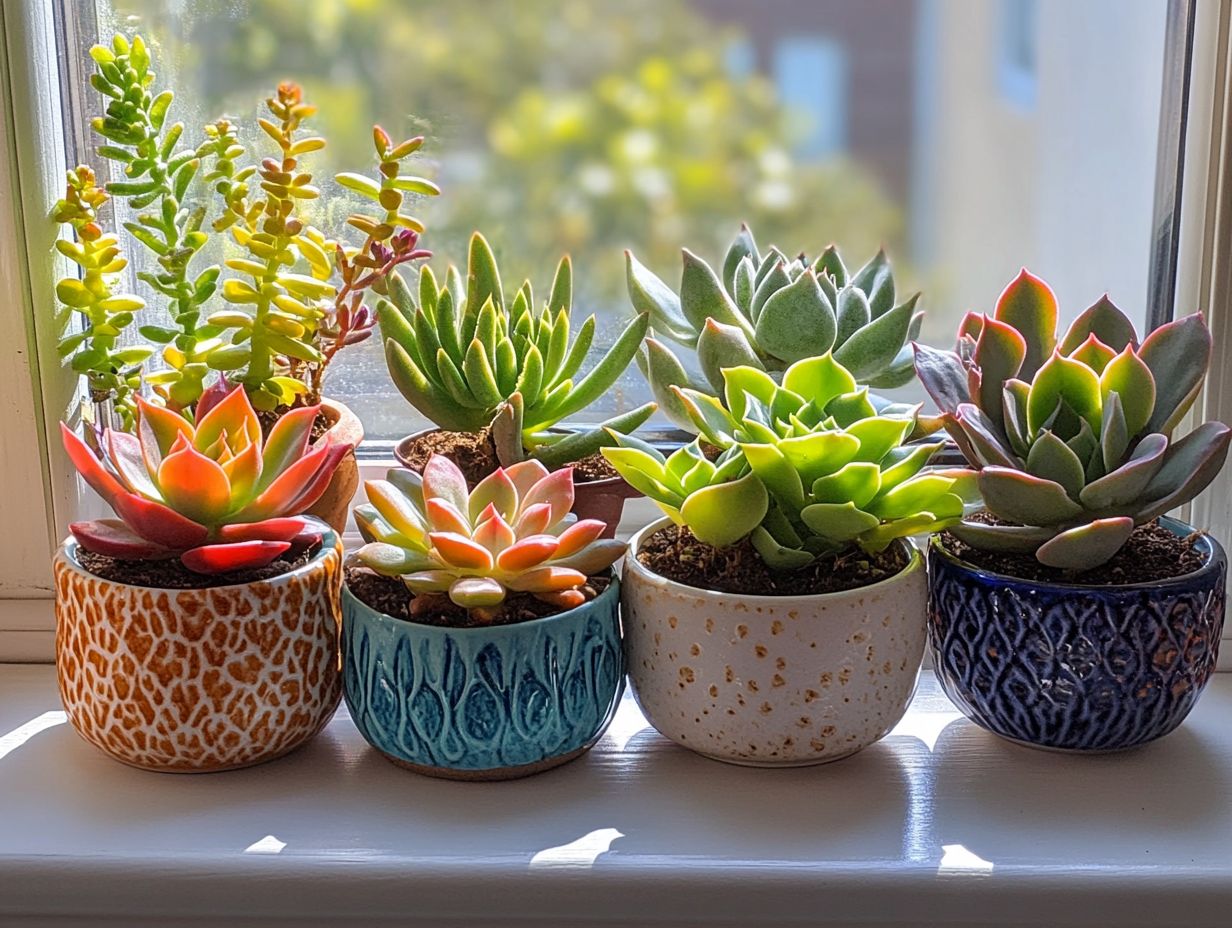
- Understanding the light requirements for succulents is crucial for their overall health and growth.
- Direct sunlight is ideal for sun-loving succulents, while shade-loving succulents thrive in indirect sunlight or artificial light.
- Monitoring and adjusting light conditions to fit the specific needs of your succulents will result in a thriving and beautiful plant collection.
Understanding Succulents and Their Light Requirements
Understanding succulents and their light requirements is essential for anyone eager to cultivate these resilient plants, whether indoors or outdoors. These hardy beauties, celebrated for their water-storing abilities, flourish in a range of light conditions, making them a favorite among gardening enthusiasts.
Whether you re nurturing low-light varieties like snake plants or basking in the glow of full-sun favorites such as jade plants and Echeveria, knowing their specific light needs is crucial for healthy growth. This guide explores the significance of light exposure, the key role of photosynthesis the process by which plants use sunlight to make their food in their development, and how to create the optimal conditions for these captivating plants.
What Are Succulents?
Succulents are a captivating collection of plants, renowned for their thick, fleshy parts that store water, allowing them to flourish in arid climates. You might be familiar with jade plants (Crassula ovata), Echeveria, Sedum, and Sempervivum each uniquely adapted to specific environmental conditions, making them highly sought after for both indoor and outdoor gardening.
These plants often hail from regions like deserts and rocky terrains, and this heritage profoundly shapes their growth habits and care requirements. For example, jade plants, native to South Africa, thrive in bright, indirect light, while Echeveria love basking in sunny spots, displaying a stunning range of colors and shapes. Sedum varieties, on the other hand, are remarkably resilient, able to withstand colder temperatures, making them ideal for outdoor landscapes.
By understanding their native habitats, you can tailor your approach to provide the perfect levels of sunlight, water, and soil conditions. This ensures that each succulent not only survives but truly thrives in its chosen environment.
Why Light Is Important for Succulents
Light is absolutely essential for your succulents, playing a key role in their growth and overall health. Without sufficient light, these resilient plants struggle to perform photosynthesis effectively, which can lead to stunted growth and undue stress. Knowing your succulents’ light needs is the key to a thriving garden!
Finding that perfect balance of light not only brings out the stunning colors unique to each species but also helps them develop strong, sturdy structures. When your succulents don t get enough sunlight, you’ll likely notice signs of stress, like elongated stems, pale leaves, or an overall droopy appearance. These symptoms are clear signals that your plants are having a tough time with photosynthesis.
On the flip side, when your succulents bask in the right amount of light, they flourish, exhibiting robust growth and a striking look that can turn any space into a lush oasis. Providing the right lighting conditions is truly the foundation for cultivating vibrant, resilient succulents.
Types of Light for Succulents
When you re nurturing succulents, understanding their light requirements is crucial for providing the best care. These resilient plants can thrive under various lighting conditions, from the intensity of direct sunlight to the gentleness of bright indirect light.
Artificial light sources like grow lights can work wonders for indoor varieties. Each succulent species has its own unique light preferences, which greatly affect its growth and overall health.
Direct Sunlight vs. Indirect Sunlight
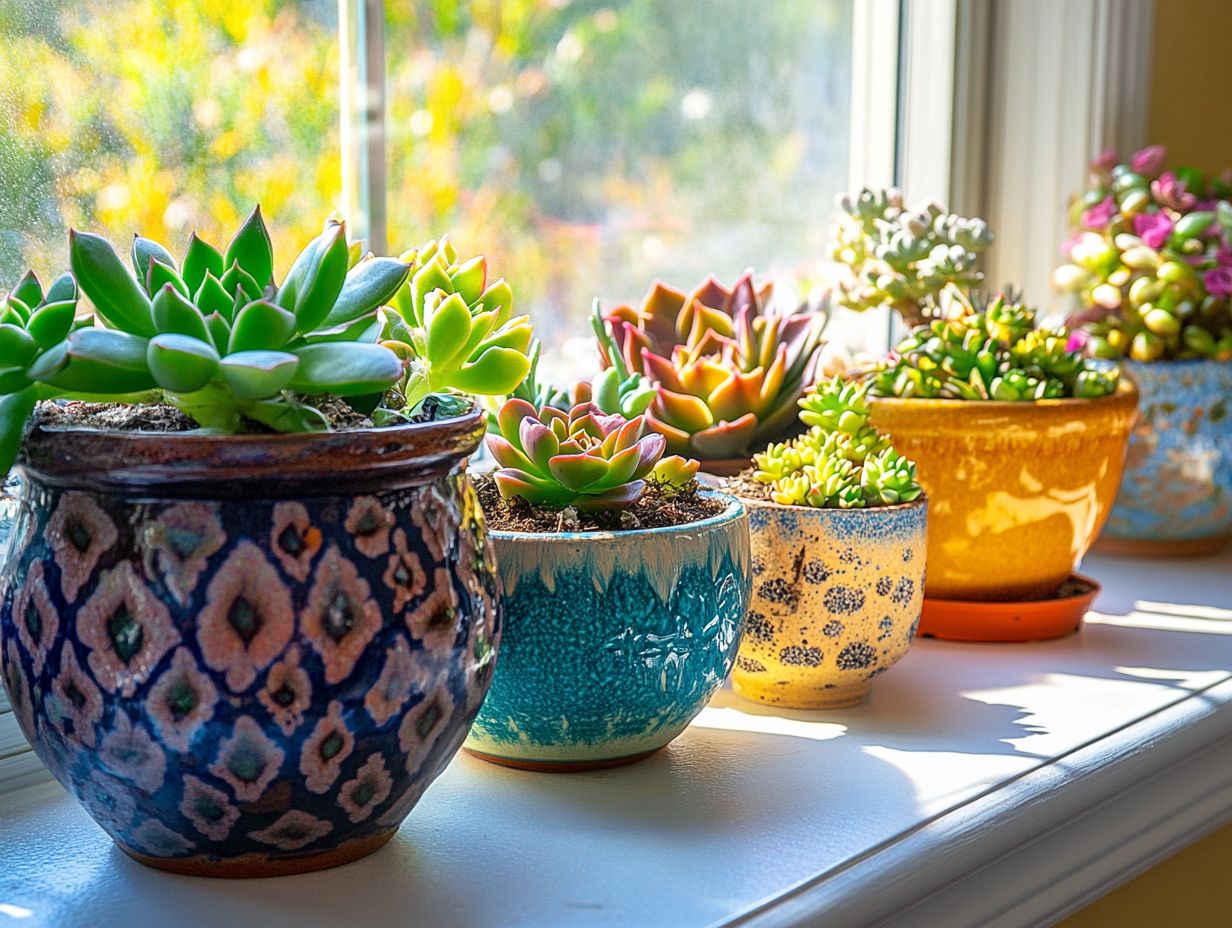
Understanding the difference between direct and indirect sunlight is essential when determining the best light conditions for your succulents. Direct sunlight means full sun exposure, which is beneficial for robust varieties. In contrast, indirect sunlight, where light is filtered, is crucial for the more delicate species that thrive in partial sun.
For instance, succulents like Agave and Echeveria flourish when they bask in several hours of direct sunlight daily, promoting healthy growth and vibrant colors. Conversely, softer varieties, such as Haworthia and certain types of Aloe, prefer filtered light that mimics their native habitats to prevent sunburn or stress.
The duration of light exposure significantly influences their growth patterns. Too much direct sunlight can lead to scorching, while insufficient light may stunt their development. Understanding these nuances allows you to create ideal environments tailored to the needs of each succulent.
Artificial Light Options
For indoor gardening enthusiasts, artificial light options like grow lights can create perfect conditions for your succulents to thrive, especially in low-light environments. Understanding different types of grow lights and their wattage is key to ensuring your plants receive the proper light exposure.
These grow lights come in various types, including LED, fluorescent, and high-intensity discharge (HID) options, each designed with specific needs in mind. For example, LEDs are energy-efficient and can emit specific wavelengths that promote succulent growth, typically favoring a color temperature around 6000K for optimal photosynthesis.
Fluorescent lights offer a broader spectrum but need to be changed often. HID lights, while powerful, can generate a lot of heat, requiring careful placement. Understanding the lumens produced by each type aids in your selection process, as brighter lights are essential for your sun-loving varieties, ensuring they flourish beautifully even in confined spaces.
How to Determine the Right Light Conditions for Your Succulents
Determining the right light conditions for your succulents requires keen observation and thoughtful consideration of several key factors that significantly influence their health and growth.
Elements such as the type of succulent, the surrounding environment, and varying levels of light exposure all play essential roles in creating optimal conditions for these remarkable plants.
Now, let s dive into how you can ensure your succulents thrive in any light conditions!
Factors to Consider
When considering the ideal light conditions for your succulents, various factors come into play. These include light levels, the growing environment, and watering practices that influence their care. Assessing these elements helps you create a tailored care guide for each succulent species you cultivate.
The choice between indoor and outdoor growing conditions significantly impacts the amount of light your succulents receive. To ensure the best care, it’s important to understand ideal conditions for indoor plants. Indoor environments may require supplements like grow lights, especially during winter months when natural light is scarce.
Outdoor settings can expose your succulents to direct sunlight, but you need to monitor the heat to prevent sunburned leaves. As seasons change, so does the angle and intensity of sunlight, meaning you ll need to adjust their placement accordingly.
Your watering habits also play a role in how well your succulents absorb light. Overly soggy soil can block essential sunlight and hinder growth. Knowing these factors empowers you to ensure optimal health for your beloved succulents.
Optimal Light Conditions for Different Types of Succulents
Creating ideal light conditions for various succulents is crucial for their health and vitality. Sun-loving succulents, such as jade plants and Echeveria, flourish in full sun. In contrast, shade-loving varieties like certain types of Haworthia prefer more moderate light levels.
By understanding the specific light requirements for each category, you can cultivate thriving plants in your garden or indoor space, ensuring they reach their full potential.
Sun-loving Succulents
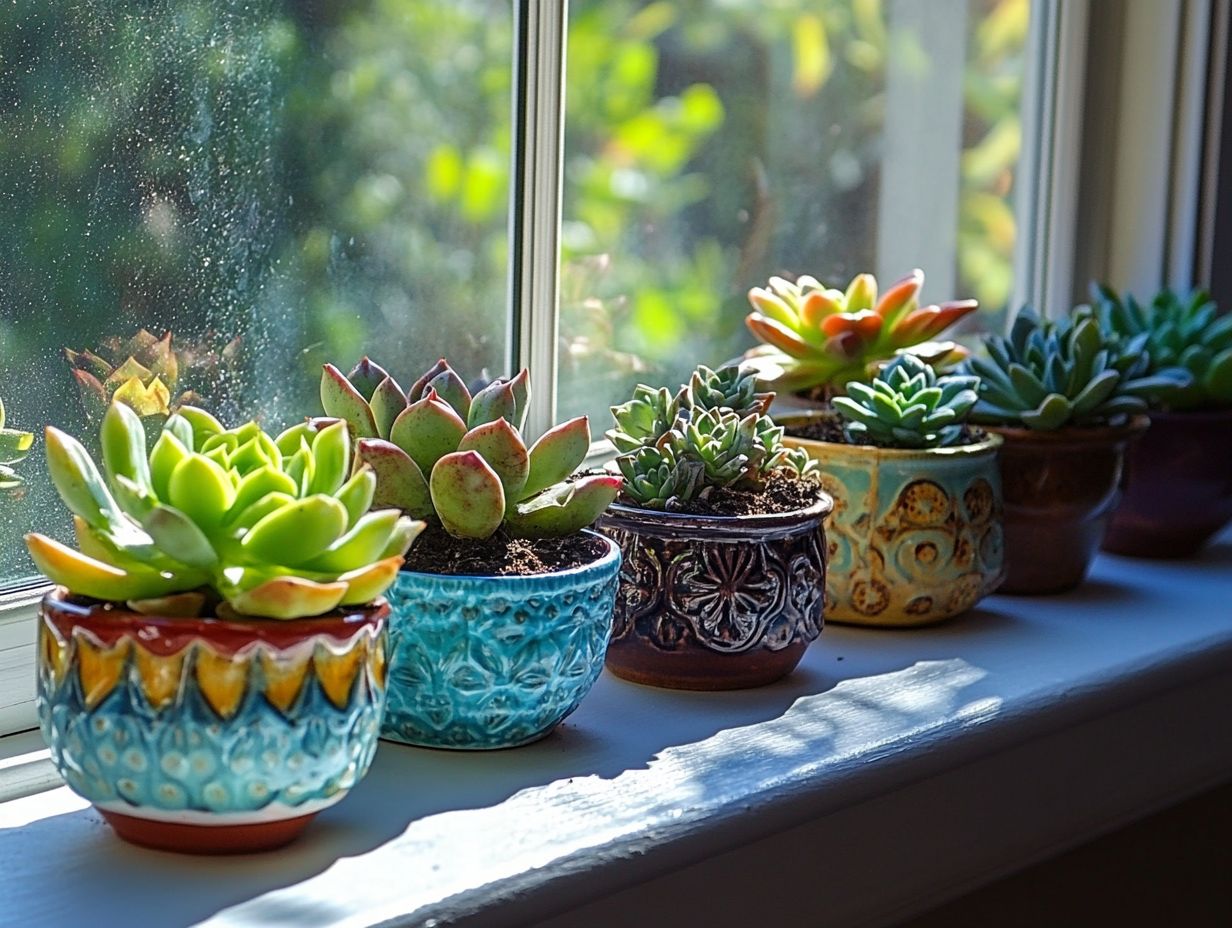
Sun-loving succulents, such as jade plants (Crassula ovata), Echeveria, and Sedum, thrive in full sun and require ample light exposure to flourish. These plants display vibrant colors and robust growth when given enough sunlight, making them ideal for outdoor gardens or well-lit indoor spaces.
To keep these beauties healthy, ensure they receive at least six hours of direct sunlight each day. Insufficient light can stunt their growth, leading to leggy, weak stems. Proper watering is just as crucial; these succulents thrive on a soak-and-dry approach, allowing the soil to dry out completely between watering sessions. Be cautious, as overwatering can lead to root rot, a condition where roots decay due to excess moisture.
Monitor their leaves for signs of well-being: plump, firm leaves indicate they re thriving, while shrivelled foliage might signal hydration issues. By understanding their specific light preferences, you can enjoy a stunning collection of sun-loving succulents that will flourish beautifully.
Shade-loving Succulents
Shade-loving succulents, such as snake plants and certain types of Haworthia, thrive in low to moderate light conditions. This makes them perfect for indoor spaces that receive minimal direct sunlight. Understanding their light preferences is key to preventing stress, such as leggy growth or discoloration.
These plants adapt well to indirect light, but they ll truly flourish near north-facing windows or in rooms with filtered light. For example, the popular jade plant enjoys these gentle light conditions and thrives in areas that shield it from harsh afternoon sun.
Caring for these succulents involves regular yet sparing watering. Too much moisture can lead to root rot, especially in low-light environments. Watch for symptoms like browning leaf tips or stunted growth; these indicators suggest they might not be getting enough light, signaling that it s time to reposition them for healthier growth.
Troubleshooting light-related issues is essential for any succulent gardener. When your plants receive either too much or too little light, they can experience significant stress.
Recognizing signs of distress like leggy growth or leaf discoloration allows you to intervene promptly. This awareness enables you to restore optimal light conditions, ensuring your succulents not only survive but truly thrive.
Symptoms of Too Much or Too Little Light
Succulents display distinct symptoms when they re exposed to too much or too little light, which can dramatically impact their health and appearance. If your plants are getting too much light, you might notice scorched leaves and faded colors.
On the flip side, inadequate light results in leggy growth and weak stems. This signals that your succulents are struggling to make their own food to meet their growth needs.
In a well-lit environment, finding the perfect balance allows your succulents to flourish. They will showcase vibrant hues and robust foliage. However, if the light intensity exceeds their tolerance, you may see tissue damage manifest as brown patches or crispy edges.
Insufficient light leads to elongated growth as your plants stretch for the light, resulting in an awkward appearance. Keeping a close eye on these symptoms is crucial, as they reflect underlying stress that could escalate into serious problems like root rot or mold if left unchecked.
To properly diagnose the situation, observe growth patterns, leaf coloration, and overall vitality to decide if it s time for some light adjustments.
How to Adjust Light Conditions for Healthy Succulents
Adjusting light conditions for your succulents is essential to foster vibrant growth and prevent stress. This might mean repositioning your plants or employing grow lights to amplify their light exposure.
Begin by evaluating the natural light in your home. South-facing windows often provide the best lighting conditions. If those spots are too hot or overly bright, don t hesitate to shift your plants a bit further from the light source.
When natural light falls short, installing a full-spectrum grow light which mimics natural sunlight and provides all wavelengths required for plant growth can effectively replicate optimal conditions.
Keep a close eye on your plants for any signs of wilting or discoloration. These can be clear indicators that they require adjustments in light or water. By harmonizing the quality of light with a consistent watering routine, you ll significantly boost their overall health and vitality.
Frequently Asked Questions
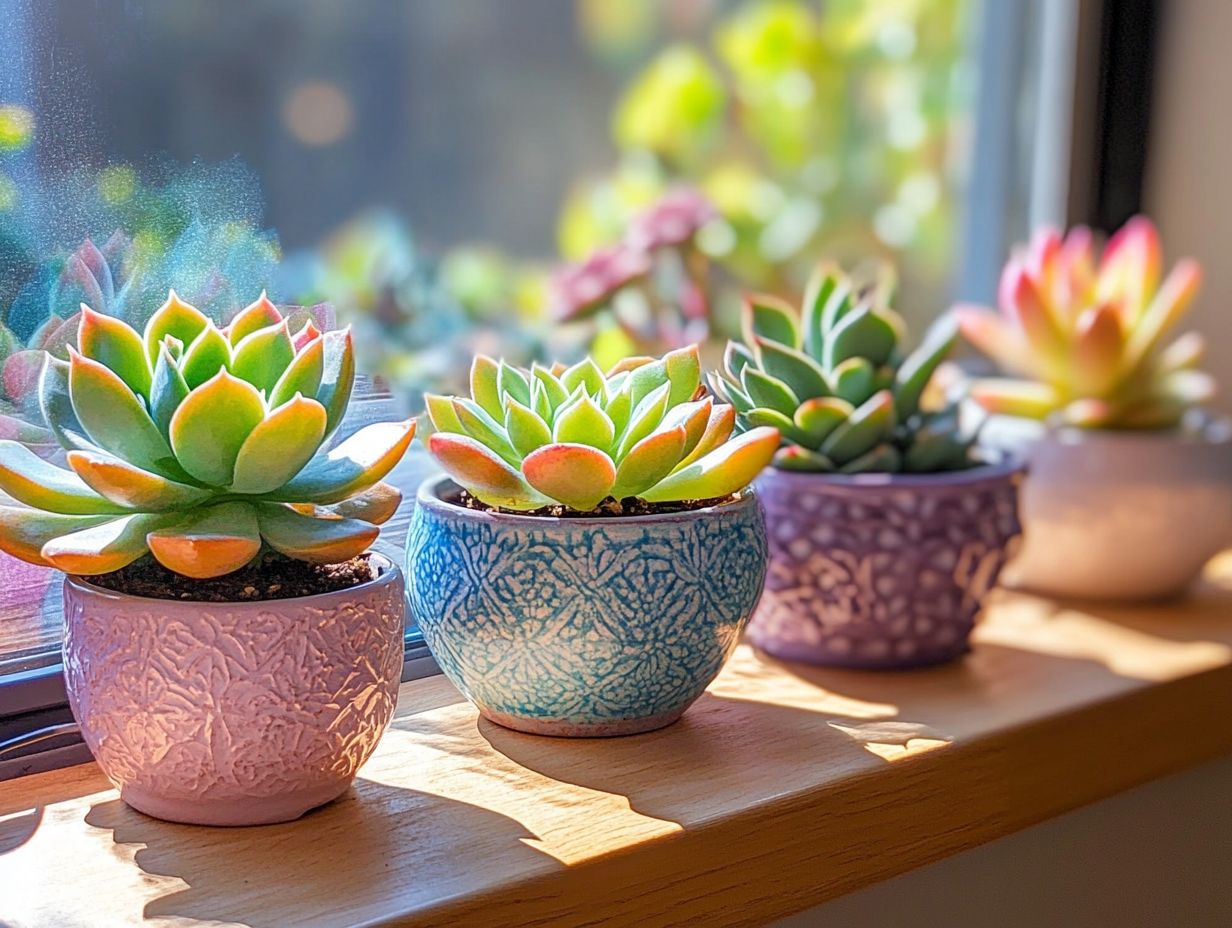
What are the optimal light conditions for succulents?
The optimal light conditions for succulents are bright, indirect light. They thrive in natural light, but direct sunlight can scorch their leaves.
Can succulents survive in low light conditions?
While succulents prefer bright light, they can survive in low light conditions for short periods. However, prolonged exposure to low light can cause them to become weak and leggy.
Do succulents need to be placed near a window?
Yes, succulents should be placed near a window where they can receive bright, indirect light. If a window is not available, artificial grow lights can be used to provide the necessary light for succulents.
How much light is too much for succulents?
Direct sunlight for more than a few hours a day can be too much for succulents. If the leaves start to turn brown or shrivel, it is a sign that the plant is receiving too much light and should be moved to a shadier spot.
Can succulents be grown indoors?
Yes, succulents can be grown indoors as long as they receive enough light. Place them near south or east-facing windows for the best results!
Do all succulents have the same light requirements?
No, different types of succulents may have different light requirements. Some may prefer more shade, while others thrive in full sun. It is important to research the specific light needs of each succulent you have to provide optimal conditions for growth.

